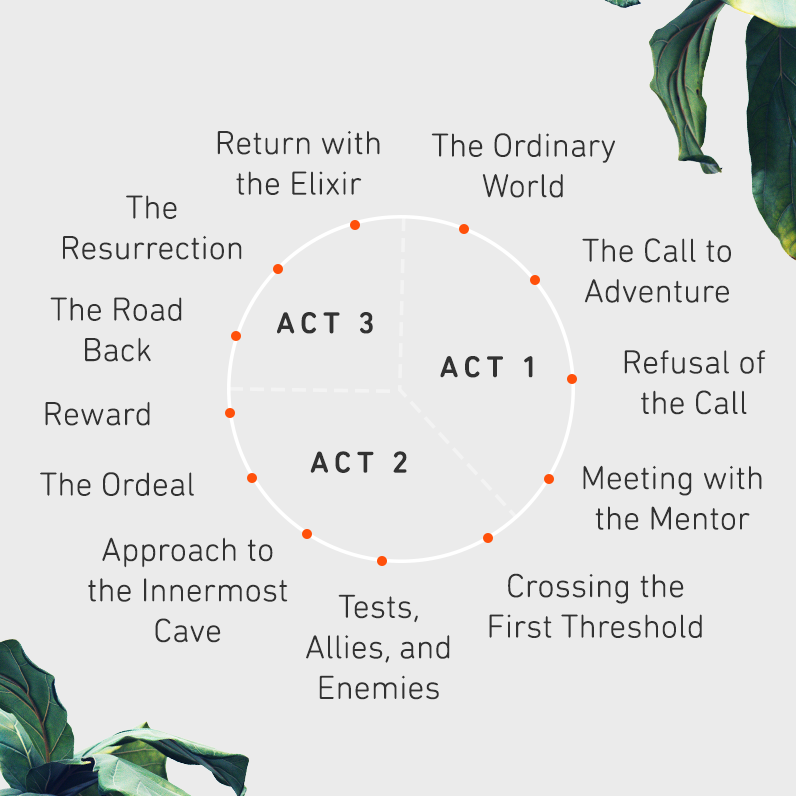A story structure is a plot mapping tool used to further character development and build a captivating arc. Writing a story or novel is a marathon, not a sprint—and it's common for authors to experience many peaks and valleys while crafting them. If you find yourself struggling with your tale, you can always turn to classic story structures to help guide the way.
Here are some of the tried and tested story structures you can use to ensure you leave no stone unturned in the development of your plot:
The three-act structure
The three-act structure divides a story into three separate acts: the setup, the confrontation, and the resolution.
Here's the breakdown of acts:
- Setup: The writer establishes the status quo. An incident occurs and the protagonist attempts to address the challenge, setting the plot into motion.
- Confrontation: The stakes grow high as the protagonist encounters new allies and enemies. At the midpoint, an event disrupts the protagonist's mission and they fail a test. This spurs doubt about their ability to succeed in achieving their overarching goal.
- Resolution: The protagonist experiences a painful period of suffering and must choose between continuing their journey or failing. This builds towards a climax where the protagonist faces off against their enemy, and usually succeeds. The denouement begins and establishes a new status quo.

The three-act structure
The Hero's Journey
When it comes to narrative structures, writer's note the Hero's Journey for its excellence. Joseph Campbell popularized hero myth pattern studies, and George Lucas repurposed them in theStar Wars series. This narrative structure suits stories that involve epic journeys of courage and triumph.
If you're looking for an accessible way to delve into the hero's journey structure, look no further. Disney development executive Christopher Vogler created a simplified 12-step version you can follow :
- The Ordinary World: The hero is living their everyday life.
- The Call to Adventure: The inciting incident of the story occurs.
- Refusal of the Call: The hero experiences some hesitation to answer the call.
- Meeting with the Mentor: The hero gains the supplies, knowledge, and confidence needed to begin the adventure.
- Crossing the First Threshold: The hero commits to the adventure.
- Tests, Allies, and Enemies: The hero explores the new world, faces trials, and makes both friends and enemies along the way.
- Approach to the Innermost Cave: The hero nears the center of the story and the new world.
- The Ordeal: The hero faces the greatest challenge yet and confronts death and rebirth.
- Reward: The hero experiences the consequences of surviving death.
- The Road Back: The hero returns to the ordinary world or continues to an ultimate destination.
- The Resurrection: The hero experiences a final moment of death and rebirth. They are pure when they re-enter the ordinary world.
- Return with the Elixir: The hero returns with something to improve the ordinary world.

The Hero's Journey
Freytag's Pyramid
This five-point story structure has roots stemming from classic Greek tragedies like Sophocles, and Euripedes. Novelist Gustav Freytag developed this structure as a description of something fiction writers have used for many years. It's a simple and popular framework that can be used for nearly any genre.
Here's the breakdown:
- Introduction: Set and setting established. An inciting incident occurs.
- Rising action: The protagonist pursues their goal. The stakes rise as three major events add suspense to the plot.
- Climax: Tension builds to a peak, leading to a turning point for the protagonist.
- Falling action: In the aftermath of the climax, tension continues to unravel, leading to catastrophe.
- Resolution: The protagonist stoops to their lowest point. They realize their greatest fears.

Freytag's Pyramid
Fichtean Curve
The Fichtean Curve structure places the protagonist in a series of crises on their journey to achieving their goals. The Fichtean Curve skips the typical introduction, going straight to the inciting incident. It is an ideal story structure for writers looking to weave tension into the fabric of their story. Looking at you, thriller and mystery writers!
Here's the breakdown:
- Rising action: The inciting incident plays out immediately. The protagonist faces a series of mini-crises. The final crisis begins the turning point that spurs the protagonist in a new direction.
- Climax: The protagonist confronts the story's conflict.
- Falling action: The story addresses unfinished business from the plot. The protagonist establishes their new normal.

Fichtean Curve
Many writers claim their stories come to them in a stream-of-consciousness manner. Others harness the power of story structuring to kick off their process. Regardless of your technique, try exploring new ways to strengthen your writing. You may find a new way to break through the writer's block, and you'll develop your unique style that leaves your fans wanting more.
Learn more about mastering the art of storytelling by accessing our writing essentials for creators.





















